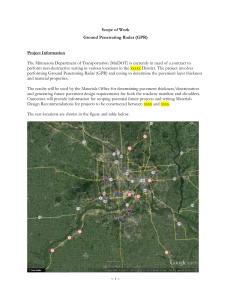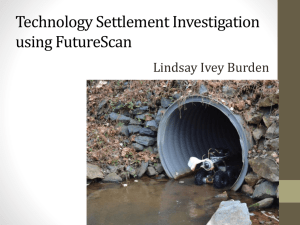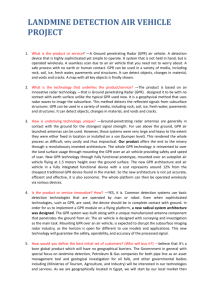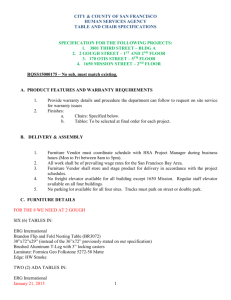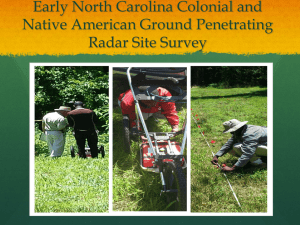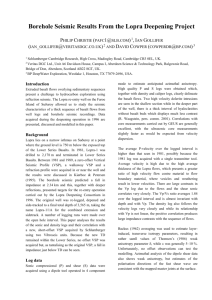stewart-(evening) searching for
advertisement
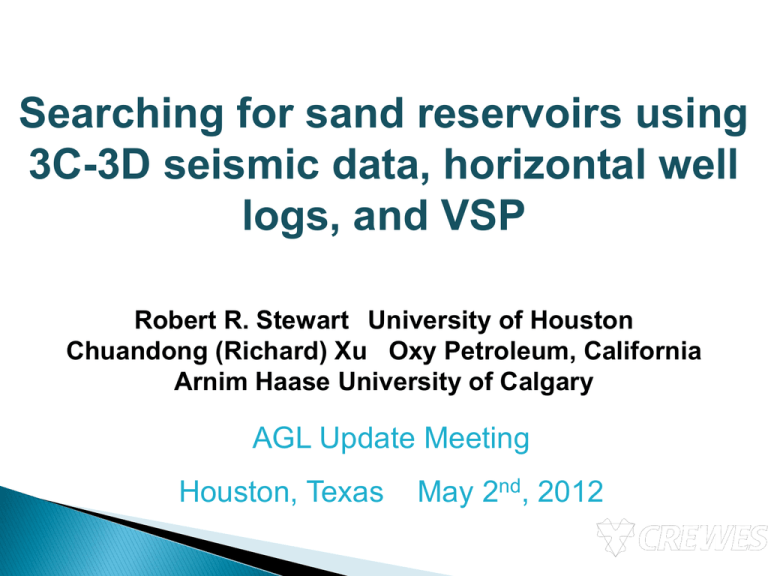
Searching for sand reservoirs using 3C-3D seismic data, horizontal well logs, and VSP Robert R. Stewart University of Houston Chuandong (Richard) Xu Oxy Petroleum, California Arnim Haase University of Calgary AGL Update Meeting Houston, Texas May 2nd, 2012 Introduction ◦ Ross Lake, northern Williston Basin ◦ Motivation – delineate reservoirs & find new ones Geology - Stratigraphy & incised valley targets Data - 3C-3D surface seismic and VSP Analysis - Interpretation of PP & PS data ◦ Time structure, time thickness, Vp/Vs Results - Horizontal well logs ◦ new targets Mannville Gp Cretaceous Geological Setting Pense Fm Cantuar Fm Success Fm Vanguard Gp Jurassic Roseray Fm Rush Lake Fm Shaunavon Fm (from Christopher, 1974) Target: Sandbars in Dimmock Creek Member of the Cantuar Formation of Mannville Group, L. Cretaceous Motivation for continued & improved exploration in the area 30 million barrel pool to be found Numerous 10 million barrel pools (Data from National Energy Board, 2001) Crossplot of Vs and Vp from 4 regional wells Regression: Vp=1.416*Vs+1070 Mudrock: Vp=1.16*Vs+1360 Vp/Vs=1.5 Vp/Vs=2.0 Vp/Vs=3.0 3C-3D seismic survey to locate horizontal well Shot by CGGVeritas Dynamite source, 3C VectorSeis® receivers Record length: 5000 ms @ 2 ms sample rate After processing, NS Inline 1-132, EW Xline 1-91, about 7.5 km2 25 Xline Inline Q type Qp Qs Spect. ratio 67 23 Drift Empir Conv/ Inst. WE Amp. Average 39 37? 57 11 82 - 58 25 From Best et al., 1994 and Calderon-Macias et al., 2004 * Q values from Ross Lake VSP 44 28 PP time, applied 5/10-50/60 bandpass filter PP data PP VSP (700m offset) PS data, Vp/Vs=2.35 AND bulk shift UP 125ms PS VSP (700m offset) PP synthetic & section (PP time) PS synthetic (PS time) PP time thickness RushLake-IHACM Map of average Vp/Vs between RushLake and IHACM Vp / Vs 2 * Tps Tpp 1 PS time thickness RushLake-IHACM Zoom of Vp/Vs map (IHACM to Rush-Lake) MD:1240 m MD:1570 m S-impedance from sparse-spike inversion Comparison of traveltime and impedance Vp/Vs Vp/Vs from time-thickness (isochron) ratios Vp/Vs from impedance ratios Horizontal well design on Vp/Vs Proposed horizontal well PP time thickness indicates channels & sand bar shape VSP and synthetic seismograms assist in PP-PS correlation. Vp/Vs from time thickness & inversions indicate reservoir sands Combining and PS data provides another reservoir delineator & additional targets Husky Energy Inc. – especially, Larry Mewhort, Kenneth Hedlin and Angela Ricci Schlumberger – in particular, Mike Jones CGGVeritas Hampson-Russell Software Services Ltd. Allied Geophysical Lab, & the CREWES Project Ground Penetrating Radar (GPR) and Total Station Survey in Robertson Stadium, University of Houston Suleyman Coskun Geophysical Data Acquisition Term Project Presentation 26 April 2012 Introduction Methods Data Acquisition Data Processing Results Conclusion The Robertson Stadium is a football stadium located in University of Houston Main Campus. Most of the stadiums have a pipeline distribution below the field in order to prevent flooding or freezing. Our 1st objective: To map the pipeline if the Robertson Stadium has one and define its spacing and top depth. Our 2nd objective: To map the topography of the field using Total Station Ground Penetrating Radar • • GPR is an electromagnetic system that emits timevarying wave pulses from the surface and receives the reflections which are created by any discontinuities encountered underground. Total Station • Total station is a modern surveying technique that uses electronic/optical distance measuring device and reflector. • Total station system can determine the coordinate and elevation information of a point by using simple trigonometry and triangulation equations. • It has has very high accuracy (~1.5mm). The fundamental basis for using GPR to determine the subsurface is the relationship between the wave velocity and material’s electrical property (permittivity). • The unit of Electromagnetic travel time is nanosecond (10-9 sec) • Penetration and Resolution depend on center frequency of system antenna. • • • • • • • • Trimble Total Station System • Point Spacing: • 5 yards in X direction • 10 yards in Y direction • 190 data point in total Dimension of the field: 300x160 ft. Data acquired from half of the field GPR System : Noggin 250 MHz Grid Line Spacing: 3 ft. Number of stack: 32 Y line: 54 – X Line: 51 Total Line length: 16,290 ft. 0.4-0.5 feet depth slice 1.7 – 1.75 feet depth slice 1.9-1.95 feet depth slice Inclination towards E-W Self- drainage system? Some geotechnical and topographic features of the Robertson Stadium at University of Houston are determined by ground penetrating radar and total station systems The drainage pipeline separation is 15 ft and the pipeline distribution has a very clear image in processed GPR data. Also GPR data indicates a shallow lineament in the East side on the study area but the source of this anomaly remains unknown. Topographic data indicates that the stadium is inclined towards East and West directions. This inclination is interpreted as a selfdrainage system that provides water to be drained from the center to the corners for preventing a flooding. Dr. Robert Stewart (Director of Allied Geophysical Laboratories) Jeremy McDonald (Director of facilities and operations - Department of Athletics) Susan Green, Ady Geda, Emrah Pacal and Anoop Williams (AGL) Ozbil Yapar, Omer Akbas, Kenan Yazan and Tuna Altay Sansal (Acquisition Crew)

